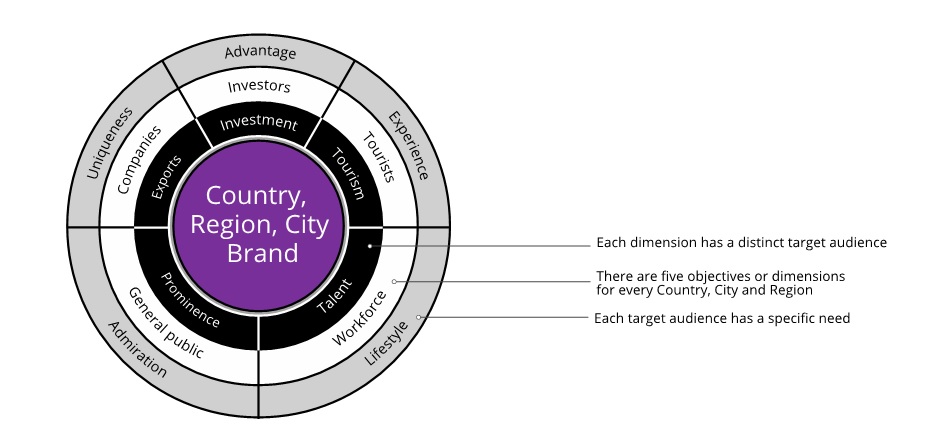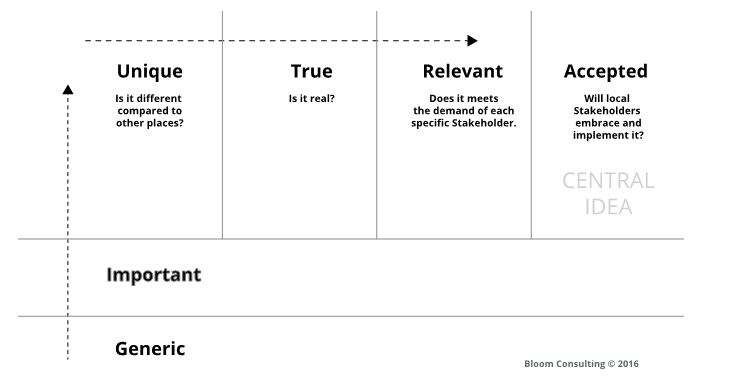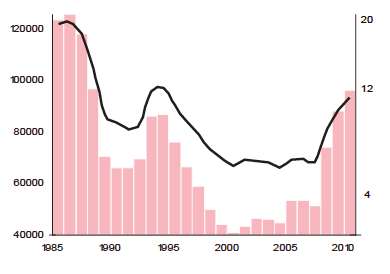Jose Filipe Torres place branding advisor and CEO of Bloom Consulting in Madrid, in this interview shares his thoughts on country branding and the growing importance of digital place brands.
Learn about:
- Why having a central idea about a place is important;
- How places can balance the economic benefits provided by tourism without sacrificing the daily experiences of their residents;
- How Googling a place and the role of digital media impact place perception;
- Some of the most important factors for countries to maintain a strong, positive reputation.
Jose, please tell us how Bloom Consulting came about and your involvement in the process
It started really early in my life. I started working in a design agency from the lowest level possible in 1994 and over time, with hard work I made it to (almost) the top. That same company believed in me and sent me to great schools in London and New York (small courses nothing big). And then in the late 90’s, I started looking to work in London or New York.
Around 2001 I was working for Futurebrand in which I won a project pitch “against” the branding agency Wolff Olins. When the project was finally delivered and since my vision of country branding was beyond just creating graphic designs, I felt it was time to create my own company.
For more than 15 years, I’ve been working in this field. It is fascinating. You have the privilege of learning about the unwritten history of countries, regions and cities and the opportunity to understand economics and social factors that would be impossible to learn otherwise.
In a recent talk at Harvard University, you spoke about how a central idea of Places may have transactional and non-transactional impacts. Can you elaborate on what makes up a central idea of a place and how these two elements play a role in it?
For me a brand of a country (or a city or a region) is something so important, so valuable and so relevant that it is able to change the socioeconomic scenario of that same country, region or city.
You can attract or repel an investor thanks to “your” reputation. The same for someone who is interested in living/relocating to that specific place… and so on for different target audiences or stakeholders.
According to the Bloom Consulting Country Brand Wheel, you can have five different stakeholders. These five stakeholders will be highly influenced by the perception they have of any country region or city.

If it is positive, you can expect a higher acceptance rate from all of them, thus having a transactional impact (the first three) and non-transactional impact, as described bellow:
- More trade
- More investment
- More tourism
- More talent
- An improved general reputation
However, it is not enough for a country to have a positive perception. Places actually need to be relevant for the five groups of stakeholders I mentioned previously and attend to a “need-state” – something they are in need of, something they are demanding.
So, nation branding or country branding (nation and country are not literally the same thing, but let’s not go there for now) is all about being relevant.
Relevance is defined through a “central idea,” which is not a slogan nor a marketing trick, but an unspoken word that countries, regions and cities should never communicate, but rather “be.” To find this “central idea,” countries, regions and cities have to actually “own” it somehow.
As illustrated bellow, here is our filtering process. Your “central idea” cannot be a “generic” thing like “quality” it needs to be a) unique b) true c) relevant and d) accepted by the place’s citizens.

Now you need to act accordingly and align your actions, activities and policies around your “central idea.” I don’t mean promotion, but rather concrete behavior, such as policies and initiatives that together repetitively, consistently, and coherently will activate the “central idea” and make it a reality.
The consequence of all this is the transactional and non-transactional impact that I mentioned at the beginning of this question. It’s simple… but not easy!
Bloom Consulting has worked significantly in the area of tourism. In what ways can communities and places balance the economic benefits provided by tourists and tourism without sacrificing the daily experiences of its residents?
Excellent question. This was probably the unforeseen challenge of places like Barcelona or Amsterdam. Actually this is a challenge that was most likely taken as “we will cross that bridge when we come to it.”
…That bridge is right there.
Yes, places need to be careful with mass tourism, but in order to truly understand the problem “one must put themselves in the shoes of others” in order to find solutions.
Tourism is extremely important for countries, regions and cities. It provides economic stability, employment, and the impact it has in the local community is, to say the least, dramatic.

Before the ‘92 Olympics, the unemployment rate of Barcelona was extremely high and the city was under severe economic pressure (see Chart 1).
Tourism in Barcelona, thanks to the Olympics (that I criticize most of the time, except for Barcelona and now maybe for Rio), played the most important role in the reconstruction of the City by revamping its economy (see Chart 1).
All this was done under sustainable growth. If you look at the visitor statistics of Barcelona you can see that the growth in visitors was having a steady positive evolution until approximately 2003 (see Chart 2).
So, Tourism was actually the solution to a problem – Let’s never forget about that.

Everything was going fine until low cost airlines arrived as you can see in chart 2. The growth rate and absolute number of tourists after 2003 is “crazy” to say the least.
According to AENA, in 2013 alone, Catalonia received 14,3 Million passengers. 8,7 Million, 60% of all passengers, came via low cost carrier.
In my opinion, the issue of mass tourism comes as a consequence of too much effort from destinations in attracting low cost carriers – As simple as that. This is most critical mainly in Europe because of the short breaks, but starting to happen in Southeast Asia as well.
What destinations need to understand is that this is “just” another segment and not the only segment. Moreover, this segment is the most “visible” one, suddenly you have two, three and even four times more people, physically in a place. This is unsustainable and of course the local population is not going to like that.
I sincerely think this is a matter of segmenting what type of tourists you want for your country, region, or city.
Bloom Consulting has worked on many projects globally. What have you found most challenging about working with such diverse places and cultures in developing a place brand? What have you found to be most rewarding?
As strange as this may sound, the challenge is always the same in every culture: The misconception of what nation branding or place branding is and the “urge” for the logo. Yes, this has changed somehow over time, but it is still the main challenge.
Of course I like the big projects, working for countries, regions and cities that are very known. Like Poland or Madrid. Regardless of how many times you do it, the rush and adrenaline is always there. BUT the projects I found most rewarding are the ones that I can see a direct impact in places that have real challenges.
Let me highlight the Abraham Path Initiative – A Place Branding project that involves Palestine and other Middle Eastern Countries together (including Israel). Place Branding contributing to building bridges… How cool is that?
How is the role of digital impacting these projects?
The Digital world is the new frontier in nation branding and place branding and should be approached much more seriously.
The Digital World = Real World
Thanks to the shift in the way we interact with technology; both from an intensity point of view and from the credibility it has gained, it has triggered a dramatic change in the behavior of global citizens towards countries regions and cities. This scenario illustrates this change in behavior:
In the past:
If any of the 5 stakeholders mentioned earlier would be interested in anything about any given country or place, they would need to ask an intermediary. For instance, for a company to do business with, they would ask the Chamber of Commerce; for a destination to visit, they would go through a travel agency; for a new place to live, they would go through relocation or consular services, and so on.
Today:
If any of those stakeholders are interested about any information for the exact same reasons, they would do it directly, specifically through the act of searching online.
According to a Google study, 65% of leisure tourists in the US generally begin researching online before they decide where or how they want to travel. 61% of them start with the search engine.
The same happens for international investors. According to research done by Bloom Consulting, more than 86% of them say that they start searching for information about potential countries to invest, using the search engine as a primary source of information.
According to a global survey by Edelman, Google has surpassed the credibility of traditional media outlets in 2015, but regardless of this, all important news outlets are also available in the digital world, thus relating to search engines and other digital platforms.
Go ahead, google your “place name” and see what shows up. It’s quick, free and a true analysis of how your country or place brand may be perceived.
One of your new tools at Bloom Consulting is the Digital Country Index. Can you share more about how this project developed and its role in contributing to country branding?
What shows up on the first pages of Google (or other search engines) is the brutal reality check of the state of the art of your country brand.
The question is: Is anyone searching for that specific place at all?
The act of “searching” can be triggered by something one may have read in a newspaper, heard in a conversation or simply out of curiosity.
No Search = No Love. Searches represent the true level of interest in a country or a place and therefore demonstrate a country’s genuine appeal. If measured, “searches” can also highlight the interests one may have.
That is what the Software Digital Demand – D2© is able to measure. What are global citizens searching for about any given place? It measures the consequence, not the cause of the search.
Bloom Consulting together with Digital Demand – D2©, has created the Digital Country Index that provides an overview of those results.
This information can help governments make informed strategic decisions regarding their past, current and future strategy. In other words, the Index aids organizational forecasting. This data can be measured and monitored constantly, which provides the opportunity to analyze changes over time.
You can download our executive summary of the results here
If you want to see the 2016 results and find out if Erdoğan, Brexit or Trump had any effect on their respective country brand, you need to either attend City Nation Place (November 2016 in London) or wait after that, since the new Digital Country Index will be released then.
In your view, which are the most important factors for countries to maintain a strong, positive reputation over time?
Be Relevant, Be Consistent, Be Bold.
Think about what you want to be perceived for and act accordingly. How to make sure your “central idea” is relevant? Look at the world’s agenda and work around it.
According to my experience and knowledge, here are the topics that countries regions and cities should look into to become relevant. There are 5 topics that fit the “World’s Agenda” and should be the “Frame of Inspiration” for governments when thinking about their identity and their “central idea”:
- Progress (Governance, innovation, invention, research…)
- Humanity (Social causes…)
- Culture (Sports, Arts…)
- Environment (Nature preservation, wildlife protection…)
- Lifestyle (Quality of life…)
Two books everyone in charge of managing city or country reputation should read…?
I would actually recommend books that are not related to nation branding, country branding or any other geographical type of branding. It may sound strange, but I believe we need to get out of our “world” in order to innovate and think differently.
I really think places need to think differently and need a fresh perspective on what type of projects they should implement in order to become relevant for their citizens. So here it goes:
Tipping Point
[easyazon_link identifier=”0316346624″ locale=”US” tag=”tpbous-20″]Tipping Point[/easyazon_link] by Malcolm Gladwell is a must read by every government leader or anyone in charge of managing the reputation of a country a region or a city. Why do I recommend this book? Because it talks about how to put your ideas forward and how to engage different types of stakeholders.
Tibor Kalman: Perverse Optimist
The [easyazon_link identifier=”1568982585″ locale=”US” tag=”tpbous-20″]Tibor Kalman: Perverse Optimist[/easyazon_link] is a book that covers something I truly believe is important for countries, region and cities – To think differently, to be creative/innovative (no logos) and to be bold.
Thank you, Jose.
Connect with Jose Filipe Torres on LinkedIn or learn more about the work and services of Bloom Consulting here.
Enjoyed our interview with Jose Filipe Torres of Bloom Consulting on the branding and digital reputation of countries, regions and cities? Spread the word!



